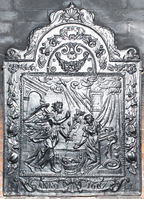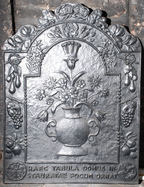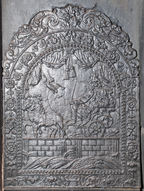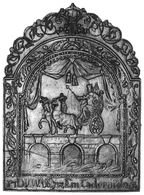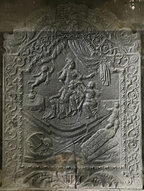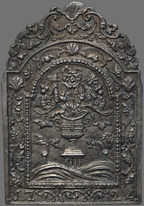-
21
Description: Rectangular central panel with bead edging all round, pictorial representation of the Annunciation by the Angel Gabriel to the Virgin Mary, the angel carries a lily, Mary kneels at a desk, between them is a basket, above them a dove descends from clouds amid sunbeams, to the left is an arch, in the centre a bed, and to the right a window and a canopy; above the panel is a bead-edged arch with a central scallop shell and a floral swag suspended from scrolls; arched rectangular shaped border with fillet edging, a cascade of leaves and fruit (inc. apples, grapes, pears and pomegranates) descending from a wreath, at the base two cartouches conjoined by a scallop shell and containing the inscription; on top a scallop shell between two dolphins.
Notes: A common fireback design originating in the Siegerland of north Germany and made for the Dutch market. A good clear casting. The illustration is copied from Virgil Solis, 'Biblische Figuren',1562.
Copies of this fireback are known.
Inscription: ANNO 1667
Manufactured: in 1667 in the Siegerland area of Germany.
Current location: Bateman's, Burwash, East Sussex, England.
Museum number: 761056 (part of the National Trust museum group)
Citation: Herskamp, W, 2007, Die Eiserne Bibel (Helios, Aachen).
- Attached to series:
- 'Dutch' Miscellaneous Firebacks
- New Testament firebacks
-
813
Description: Arched rectangular central panel with bead and fillet edging; two-handled vase with flowers issuing from it, a triple plume of ostrich feathers above, and in the bottom right corner the inscribed inscription, 'CofA' [Charteris of Amisfield]; arched rectangular border with fillet edging; central rose at top of arch with other flowers to each side; successive bunches of pears, grapes and apples descending down each side; inscription (Haec tabula domus instauratae focum ornat) in relief in two rows along the bottom, with circular badges of the National Heritage Memorial Fund to left, and National Trust to right; on top, rope knotted in two loops, each containing half of the date in relief, with descending leaves and flowers on each side.
Notes: This fireback was cast for Martin, Lord Charteris of Amisfield (1913-99), Trustee of the National Heritage Memorial Fund, from a pattern he designed and made, to commemorate the completion of restoration work to Canons Ashby.
Inscription: 1984 / CofA / HAEC TABULA DOMUS IN- / STAURATAE FOCUM ORNAT [this plate adorns the hearth of a restored house]
Manufactured: in 1984 in England.
Current location: Canons Ashby, Canons Ashby, Northamptonshire, England.
Museum number: 494619 (part of the National Trust museum group)
- Attached to series:
- British 'Dutch' style firebacks
- Commemorative firebacks
- Martin Charteris firebacks
-
222
Description: Arched rectangular central panel with ‘nutshell’ edging on a broad fillet; crowned figure, holding a sceptre in his right hand, sitting in a chariot drawn to the left by two horses with ostrich feather head-dresses; the whole upon a causeway with pilasters and masonry, and waves beneath; a heron flying to the left; above, swagged drapery with two tassels hanging from the centre; arched rectangular shaped border with fillet edging, symmetrical, flower bunches, descending from a ribbon loop; monogram centre bottom, between plant tendrils; on top, symmetrical scrolled plant tendrils.
Notes: The design is derived from a personification of Europe, one of a set of playing cards entitled 'Jeu de la Géographie', designed by Stefano della Bella (1677); a similarity with Queen Anne may not be coincidental; the flying heron has been copied from a print by Wenceslaus Hollar c.1658.
Copies of this fireback are known.
Inscription: SHR
- Decoration tags:
- 'Dutch' (shape)
- fillet (edging)
- whole carved pattern
- pictorial
- allegorical
- monogram
- text
- animals
- humans
- objects
Manufactured: in the late-17th to early-18th century in England.
Current location: Canons Ashby House, Canons Ashby, Northamptonshire, England.
Museum number: NT/L/CAN/M/79 (part of the National Trust museum group)
- Attached to series:
- SHR series
- British 'Dutch' style firebacks
-
226
Description: Arched rectangular shaped central panel with bead-and-pellet edging on a wide fillet; central pedestal with a wyvern fountain ringed with water, and a swan and a duck swimming, plants rising from the waves; above, swags of drapery with two central tassels; arched rectangular shaped border with fillet edging, symmetrical floral fronds descending from a rose, top centre, with a looped 'W' in each shoulder; inscription at base, between date; on top, symmetrical scrolled plant tendrils. A single vertical plankline right of centre.
Notes: One of a group of firebacks all of the same date, some of which have the same Welsh inscription which translates as 'God is our strength'. All incorporate the looped 'W' motif which may be intended to identify the pattern maker. The design is taken from 'Livres de Fontaines' by Daniel Marot (1661-1752) (La Haye & Amsterdam 1701). The swan and the duck swimming may have been copied from etchings or paintings by Francis Barlow (c.1624-1709), whose images of birds have been used incidentally on other firebacks. Formerly at Allt-y-ferin, Nantgaredig, Carmarthenshire.
Copies of this fireback are known.
Inscription: 17 DVW Ydyw Ein Cadernid 24
- Decoration tags:
- 'Dutch' (shape)
- fillet (edging)
- whole carved pattern
- planklines
- pictorial
- architectural
- text
- animals
- plants
- objects
Manufactured: in 1724 in England.
Current location: National History Museum, St Fagans, Glamorgan, Wales.
Museum number: 62.156 (part of the Welsh National History Museum museum group)
- Attached to series:
- 1724 series
- Welsh inscription series
- British 'Dutch' style firebacks
-
233
Description: Arched rectangular central panel, bead edging, a stork, to the left, its beak in the top of a tall vase, a fox seated to the right, a tree behind; arched rectangular border, fillet edging, swags of fruit bunches (missing at the sides) suspended from ribbon, inscription below central panel; on top, symmetrical floral swirls and flowers.
Notes: The scene is drawn from 'The Fox and the Stork', one of Aesop's fables. A recasting. Formerly at Ffynnon Deilo, Pendoylan, Glamorgan.
Copies of this fireback are known.
Inscription: 16 NDW 97
- Decoration tags:
- 'Dutch' (shape)
- fillet (edging)
- whole carved pattern
- pictorial
- mythological
- text
- animals
- objects
Manufactured: in 1697 in the Siegerland area of Germany.
Current location: National History Museum, St Fagans, Glamorgan, Wales.
Museum number: 59.461 (part of the Welsh National History Museum museum group)
- Attached to series:
- 'Dutch' NDW series
-
238
Description: Arched rectangular shaped central panel with bead-and-pellet edging on a wide fillet; crowned figure, holding a sceptre in his right hand, sitting in a chariot drawn to the left by two, caparisoned horses with ostrich feather head-dresses; the whole upon a three-arched bridge with keystones and a string course, waves beneath; above, swagged drapery with two tassels hanging from the centre; arched rectangular shaped border with fillet edging, symmetrical, descending oak leaf and acorn branches, with a looped 'W' in each shoulder; inscription at base; on top, symmetrical scrolled plant tendrils and berries. A single central vertical plankline.
Notes: One of a series produced in the same year. All incorporate the looped 'W' motif which may be intended to identify the pattern maker. The design is derived from a personification of Europe, one of a set of playing cards entitled Jeu de la Géographie, designed by Stefano della Bella for Louis XIV. The inscription translates as 'God is our strength'.
Copies of this fireback are known.
Inscription: 17 DVW Ydyw Ein Cadernid 24
- Decoration tags:
- 'Dutch' (shape)
- fillet (edging)
- whole carved pattern
- planklines
- pictorial
- allegorical
- text
- animals
- humans
- objects
Manufactured: in 1724 in England.
Current location: Tredegar House, Pencarn Way, Duffryn, Newport, Gwent, Wales.
Museum number: F81.233 (part of the Welsh National History Museum museum group)
- Attached to series:
- 1724 series
- Welsh inscription series
- British 'Dutch' style firebacks
-
240
Description: Arched rectangular shaped central panel with bead-and-pellet edging on a wide fillet; ground with birds, and trees behind; in the centre a circular fountain rim with a swan on a plinth surrounded by water, with jets of water rising from the swan’s mouth and descending on either side; above, a heron and a goose fly to the left; under the arch, swags of drapery; arched rectangular shaped border with fillet edging, symmetrical floral fronds descending from a scallop shell, top centre, with a looed 'W' in each shoulder; inscription at base between date; on top, symmetrical scrolled plant tendrils. A single central vertical plankline.
Notes: One of a group of firebacks, all of the same date, some of which have the same Welsh inscription which translates as 'God is our strength'. All incorporate the looped 'W' motif which may be intended to identify the pattern maker. The design is adapted from an illustration of fountain no. XXXIX, 'Les Cannes et le Petit Barbet' in Labyrinthe de Versailles by Sébastien le Clerc (1677); the flying heron and duck are copied from illustrations by Francis Barlow (c1626-1704) or from engravings of his work by Wenceslaus Hollar (1607-77).
Copies of this fireback are known.
Inscription: 17 DVW Ydyw Ein Cadernid 24
- Decoration tags:
- 'Dutch' (shape)
- fillet (edging)
- whole carved pattern
- planklines
- pictorial
- architectural
- text
- animals
- objects
Manufactured: in 1724 in England.
Current location: Newton House, Dinefwr, Llandeilo, Carmarthenshire, Wales.
Museum number: F83.116 (part of the Welsh National History Museum museum group)
Citation: Lloyd, N., 1925, 'Domestic Ironwork I', Architectural Review, 58, pp. 58-67.
- Attached to series:
- 1724 series
- Welsh inscription series
- British 'Dutch' style firebacks
-
874
Description: Arched rectangular central panel with ovolo linking curves and eyelet astragal edging; pictorial scene of Delilah, seated above a pavement, supervising the cutting of Samson's hair by a barber, a putto to the left and a small figure lower right; drapery above; arched rectangular border with ovolo linking curves and fillet edging; symmetrical pattern of plant tendrils with leaves and seed pods; at bottom, monogram 'EB' in a cartouche between symmetrical leaves and ears of wheat; on top, two mirrored sea serpents.
Notes: One of a small series of firebacks identified by the EB monogram; the pictorial scene is of Delilah and the sleeping Samson with a Philistine cutting his hair; the scene may be based on an engraving by the Dutch artist Philip Galle (1537-1612) after a painting by Maerten van Heemskerck.
Copies of this fireback are known.
Inscription: EB
Manufactured: in the late-17th to early-18th century in England.
Current location: Chastleton House, Chastleton, Oxfordshire, England.
Museum number: 1430205 (part of the National Trust museum group)
- Attached to series:
- EB series
- Old Testament & Apocrypha firebacks
- British 'Dutch' style firebacks
-
1032
Description: Arched rectangular shaped central panel with solid and hollow bead on fillet edging, grouped alternately in threes and twos respectively, on a wide fillet; on a Tuscan pedestal rising from waves, a narrow waisted, gadrooned flower vase with two scrolled handles and a horizontal banded decoration from which issue tendrils bearing flowers, berries and seed pods; arched rectangular shaped border with fillet edging, wide at the sides, symmetrical floral fronds descending from a scallop shell, top centre, with a scallop shell inside each shoulder; at base, date split between two looped 'W' figures; on top, symmetrical scrolled plant tendrils descending from a central scallop shell.
Notes: The third largest of six flower vase firebacks designed and made in the same year, larger ones of which include a religious inscription in Welsh. All incorporate the looped 'W' motif which may be intended to identify the pattern maker. Cheffins auction, Cambridge, 13 Jun 2018, lot 738 (£240).
Copies of this fireback are known.
Inscription: 17 24
Manufactured: in 1724 in England.
Current location: not known.
- Attached to series:
- 1724 series
- British 'Dutch' style firebacks
-
35
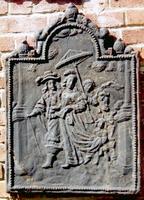 ? x ? mm
? x ? mmDescription: 'Dutch' style; arched rectangular shaped with bead edging; figures of a man and woman walking, in dress of the mid-17th century, a page holding the woman's train. followed by a man holding a parasol, and by a horse; they pass between the bases of two columns; above is foliage and clouds. On top are two serpents and three pomegranates arranged symmetrically.
Notes: The pictorial scene is based on an engraving c.1642 of Friedrich Wilhelm, Elector of Brandenburg, and his wife, Luise Henriette of Oranje-Nassau, by Mathias Czwiczek; one of series of firebacks depicting allegories of the four continents.
Copies of this fireback are known.
Manufactured: in the mid-17th century .
Current location: in private hands, Chichester, West Sussex, England.
- Attached to series:
- 'Dutch' Continents firebacks
- 'Dutch' Borderless series
